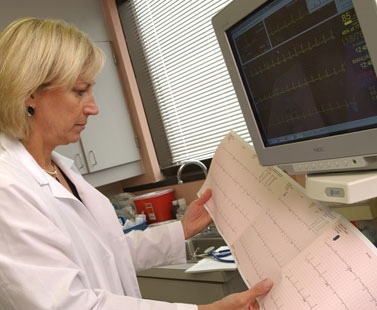USF Cardiology Chief coauthors New England Journal of Medicine editorial

Dr. Anne Curtis, USF chief of cardiology, reviews an EKG.
USF Chief of Cardiology Anne Curtis, MD, weighs in on the setbacks in rhythm control for atrial fibrillation in the June 19 issue of the New England Journal of Medicine.
Dr. Curtis and colleague Michael Cain, MD, Dean of the School of Medicine and Biomedical Sciences, University of Buffalo, comment on the results of the international multicenter Atrial Fibrillation and Congestive Heart Failure trial comparing a rhythm-control strategy with a rate-control strategy in patients with congestive heart failure and a history of atrial fibrillation, a common heart rhythm disorder. The first therapeutic strategy aims at restoring and maintaining sinus (normal) heart rhythm with antiarrhythmic drugs and electrical cardioversion when appropriate. The second focuses on using drugs to optimize the ventricular heart rate.
The study results, reported by Roy et. al in the same NEJM issue as Drs. Curtis and Cain’s editorial, indicated no significant difference in cardiovascular death rates in the rhythm-control group and the rate-control group. Furthermore, deaths from any cause and worsening heart failure were not significantly different in the two groups.
“Studies thus far haven’t been able to demonstrate that rhythm control is superior to rate control,” Dr. Curtis said. “Cardiologists use antiarrhythmic drugs to try to turn an abnormal rhythm into a normal rhythm, yet these drugs don’t work as well as we’d like and they can have toxic side effects.”
The NEJM editorial submission preceded the recent release of ATHENA trial results indicating that the investigational drug dronedarone, envisioned as a safer alternative for maintaining sinus rhythm, seemed to cut the risk of cardiovascular hospitalizations or death. In addition, clinical trials planned and in progress are testing the effectiveness of ablation, a procedure in which the source of a patient’s irregular heartbeat is mapped, localized and destroyed (ablated) by radiofrequency energy or freezing.
“The optimal treatment for atrial fibrillation is still a moving target. The best advice we can give to patients at this point is that the treatment strategy will ultimately depend upon the characteristics of the arrhythmia, the patient’s symptoms, and the presence or absence of structural heart disease,” Dr. Curtis said. Whether medical management or a catheter ablation procedure is the best course of action should be discussed with the patient’s physician. When patients have symptoms that are difficult to manage, referral to an electrophysiologist (a cardiologist who specializes in heart rhythm disorders) may be appropriate, she added.
Dr. Curtis is a past president of the Heart Rhythm Society.
Atrial fibrillation is a major cause of hospitalization and death, affecting about 2.5 million people in the United States. Without appropriate management, the disorder can lead to serious complications, such as stroke and congestive heart failure.
– Story by Anne DeLotto Baier, USF Health Communications

